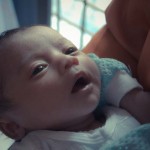Alzheimer’s Gene Effects May Show Up in Infancy
 Infants and toddlers with the Alzheimer’s disease-associated APOE4 genotype already showed distinctive patterns of brain structure relative to other young children, researchers said.
Infants and toddlers with the Alzheimer’s disease-associated APOE4 genotype already showed distinctive patterns of brain structure relative to other young children, researchers said.
MRI scans carried out in 60 normally developing children, age 2 to 25 months, who carried the APOE epsilon-4 allele, showed smaller volumes of gray matter and and lower white matter myelin water fraction (MWF) compared with 102 children in the same age range whose APOE genes only include the epsilon-2 and/or epsilon-3 alleles, according to Sean C. L. Deoni, PhD, of Brown University in Providence, R.I., and colleagues.
“While our findings should be considered preliminary, this study demonstrates some of the earliest brain changes associated with the major genetic risk factor for late-onset Alzheimer’s disease,” the researchers wrote online in JAMA Neurology.
Because MWF is a measure of myelination, the finding of reduced MWF may suggest that nerve fibers in APOE4 carriers have less of the protective myelin coating and are therefore more vulnerable to neurodegenerative pathologies. APOE genotype has previously been linked to differences in beta-amyloid protein processing, with the epsilon-4 allele associated with greater production of a form prone to fibril and plaque formation.
Deoni and colleagues indicated that their working hypothesis was that APOE4 carriers “have neurodevelopmental alterations that provide a foothold for the neuropathological changes associated with the subsequent course of Alzheimer’s disease.”
In an accompanying editorial, two researchers from Massachusetts General Hospital in Boston, John Growdon, MD, and Bradley Hyman, MD, PhD, noted several methodological concerns about the study.
Nevertheless, they indicated, the study results “raise intriguing questions about the kind of substrate in the developing nervous system that might predispose to AD neuropathological changes and neurodegeneration much later in life.”
Other experts contacted by MedPage Today agreed that the study was interesting, but the implications for Alzheimer’s disease risk prediction and prevention remained uncertain.
Zaven Khachaturian, PhD, editor-in-chief of Alzheimer’s and Dementia, commented that the findings — even if true — may not have any clinical relevance.
“My concern is that a mere validation study to confirm this observed ‘association’ in a larger study will only perpetuate the prevailing models/ideas/assumptions about Alzheimer’s disease pathophysiology, which thus far have not been productive in generating any effective interventions — as demonstrated by the repeated failure of several clinical trials based on these ideas,” he wrote in an email.
Although the role of apolipoprotein E, the product of APOE expression, in Alzheimer’s disease is typically couched in terms of its impact on beta-amyloid trafficking, Khachaturian noted that its main function is in cholesterol transport, “which suggests a far more broad set of possibilities regarding neural functions/functionality such as synaptic turnover/repair,” he said. Also, the APOE4 genotype is not causative of Alzheimer’s disease, but only a risk factor, he said.
He also pointed out that the study, conducted only in very young children, does not address whether the differences persist through later childhood and beyond. And, even if they do, other studies have indicated that differences in brain structure do not correlate well with cognitive function.
“The link between image changes and clinical pathology is tenuous,” Khachaturian said.
F. Sessions Cole, MD, director of the newborn medicine division and chief medical officer at St. Louis Children’s Hospital, told MedPage Today that a long-term follow-up study would be the best way to answer some of these questions.
Such a study, following APOE4 carriers and noncarriers over time, could “define the metabolic profiles of affected and unaffected brain regions as well as risk factors that modify development of Alzheimer disease.”
But that would take decades, Cole said. He agreed with Khachaturian about the limited correlation between the APOE4 genotype and Alzheimer’s disease — an important point if one were to develop a preventive treatment to be given during childhood to APOE4 carriers.
“As of today, I think that it would be unethical, based on this study, to initiate a potentially brain-modifying therapy in possibly affected children,” he said.
The 162 infants and toddlers recruited for the study underwent imaging while they slept. Analysis of gray matter volume was limited to 59 of the children — many of the others woke up before the scanning was completed, and Deoni and colleagues decided to exclude children younger than 6 months after discovering that the automated image-processing algorithm did not work reliably in them.
For the MWF measurements, the researchers found that APOE4 carriers in the entire cohort had lower values than the control children in posterior white matter areas, “including the optic radiations, corticospinal tracts, and splenium of the corpus callosum,” they wrote. Carriers also had greater MWF in the frontal white matter, especially the corona radiata, genu of the corpus callosum, and orbitofrontal cortex.
These patterns were also true when the analysis was limited to participants age 2 to 6 months.
Reductions in gray matter volume were concentrated in the bilateral precuneus, posterior and middle cingulate, and occipitotemporal and left lateral temporal regions. Increased gray matter volume in carriers versus noncarriers was seen in medial and lateral frontal regions.
Comparison of older versus younger participants demonstrated “an attenuated relationship” between MWF and age in posterior white matter regions in APOE4 carriers, whereas the relationship was strengthened in later-developing frontal areas of white matter.
But while these associations met standard criteria for statistical significance, Growdon and Hyman pointed out that they represented a small proportion of the number of potential associations examined in the study. “Most results do not hold up to multiple comparison testing, making this more of a hypothesis-generating data set than a confirmed set of observations,” they wrote in the editorial.
Also, the editorialists pointed out that the regions of interest selected for the study were chosen on the basis of “prior experience in Alzheimer’s disease, so a certain circularity in logic is inevitable.”
